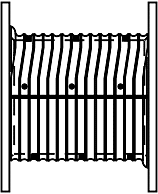Hydraulic Winch Q & A
 Q:
What is LeBusŪ lagging?
Q:
What is LeBusŪ lagging?
A: The LeBus lagging system, shown in the drawing, begins with a grooved winch
drum. The grooves are parallel to the flanges, not angled in one direction or
the other. Halfway around the drum the grooves shift over one-half the pitch
distance of the grooves. This same shift repeats halfway around on the other
side of the drum.
As the first layer of cable spools onto the drum, it positions
itself into the most convenient groove. The next layer follows this pattern,
with each wrap of cable resting in the groove formed by two adjacent wraps in
the layer below. The upper and lower layers are stacked perfectly over
approximately 80 percent of the circumference. The layers cross wind over the
remaining 20 percent of the circumference.
The LeBus lagging system yields significant benefits that
frequently offset its cost. This smoother, more natural lay of the wire rope
reduces wear on the cable, which yields safer operation and reduced wire rope
cost. Because each layer of cable is spooled without an orientation toward one
side of the drum or the other, as with smooth or grooved drums, the fleet angle
can be increased, reducing the amount of space required for the winch.
 Q:
What is LeBusŪ lagging?
Q:
What is LeBusŪ lagging?